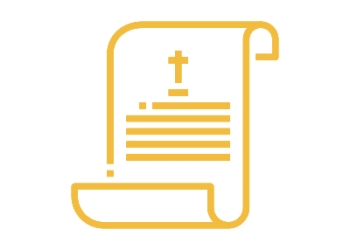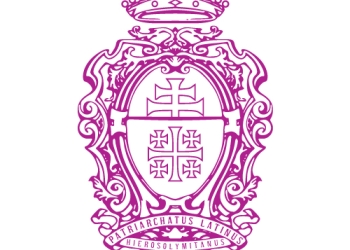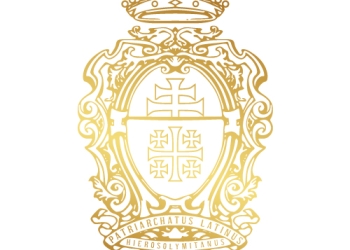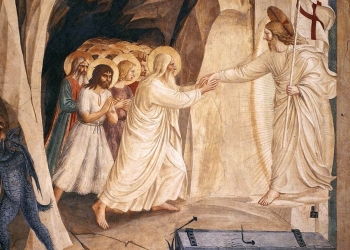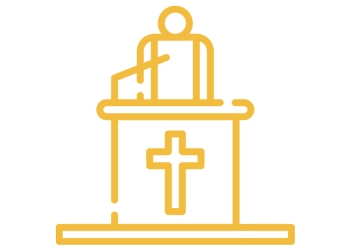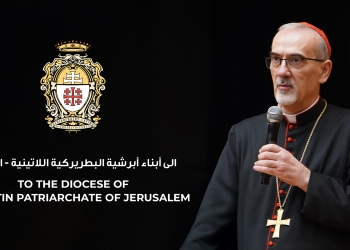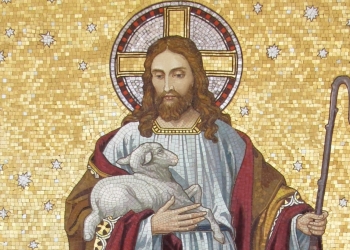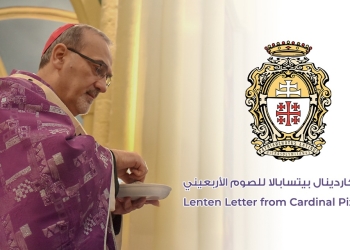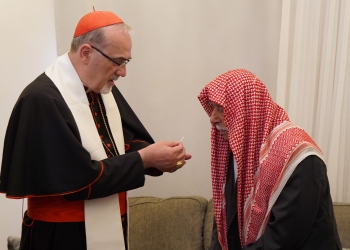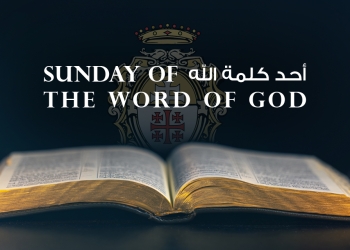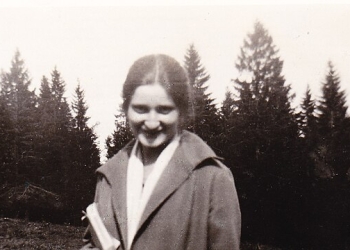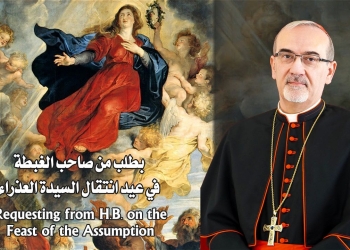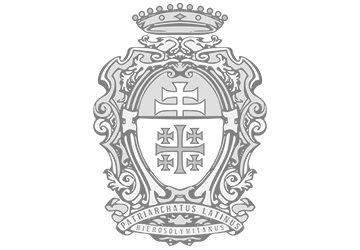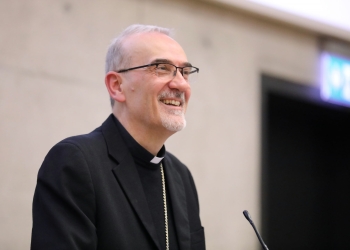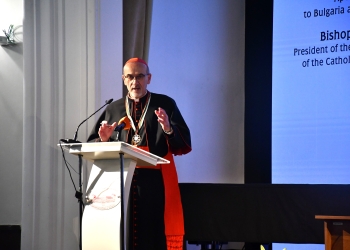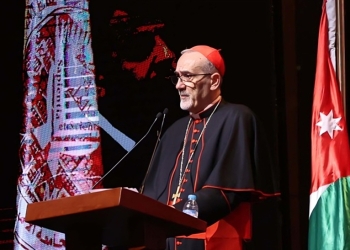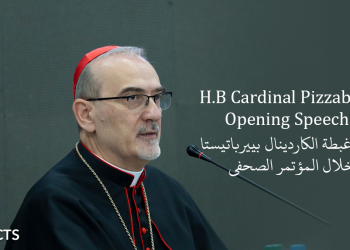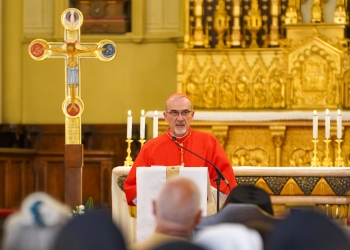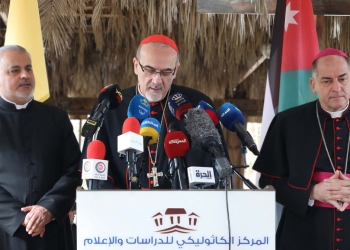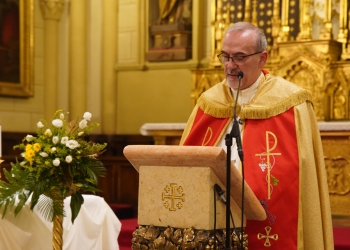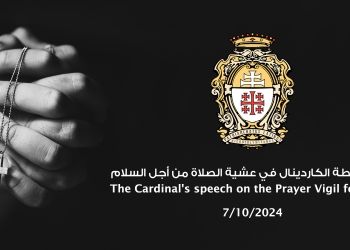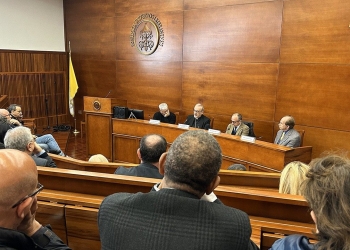Jerusalem: Between Reality and Vocation - A Light for Peace
Fribourg, November 14th, 2025
Academic Authorities,
Dear Students,
Friends,
It is a profound honor, and an even greater responsibility, for me to be here today. I am not here as an expert in international or geopolitical affairs, nor as an academic specializing in international relations, but as a pastor – a witness who comes from the lived experience of the Holy Land. I am here to attempt to give voice to the silent cry of a land that still bleeds and hopes. And as a pastor, I wish to express myself.
I do not intend to recount the events of these past two years, which everyone has followed through the media. Now that the acute phase of the conflict seems to have ended, even though everything remains to be rebuilt – not only infrastructure, but even more so humanity and trust – we may have more inner space than before to try to understand what and how this armed clash has decisively changed, not only our personal perceptions, but also the relationships among the various communities.
If I had to encapsulate the condition of humanity in the Holy Land during these months in one image, it would be this: pain that does not see the pain of others. The heart is so full, so invaded, so torn by its own suffering that it cannot find even a millimeter of space for the suffering of another. Everyone feels like a victim – the only victim – of this tsunami of hostility.
In this landscape of material and moral rubble, the recent truce has brought us precarious relief, but not serenity. The end of hostilities does not mark the beginning of reconciliation. The wounds are too deep.
So, where do we begin again? What language can we use when all words seem worn out? What horizon can we look to when the smoke of explosions has obscured our heaven for so long?
It is from this question that my reflection today is born. I would like to guide you on a journey that rises from the raw reality of a wounded land toward an eternal vocation. A journey whose beacon and compass is the most powerful and contradictory symbol in human history: the city of Jerusalem.
I will not delve into political issues and responsibilities – not because I am afraid to do so. I have already stated my opinion on the matter several times, and it is not necessary for me to repeat myself. Furthermore, this prestigious venue calls for reflections that I will try to keep as elevated as possible. I will try to scratch the surface of reality, to question an idea, a dream, a vocation inscribed in the very heart of Revelation.
1.0 The Reality - The Rubble of the Present
First, as I said, it is necessary to become aware of where we now find ourselves: in community relations, in social and political perspectives, and in religious life, which has such an important influence on the civil life of the peoples of the Holy Land. Since October 7, 2023, we have been immersed in a sea of blood and fire. We have experienced death, destruction, resentment, and the desire for revenge. With God’s help, we have tried to be a bridge and to keep a spark of hope alive. Now, the ceasefire has brought scenes of jubilation, but joy is accompanied by deep skepticism, because we know that the real challenge begins now.
The crisis has damaged years of painstaking interreligious dialogue, which is now struggling to restart. It has dismantled the illusion of easy prospects for peace or a short-term solution to the Israeli-Palestinian political question. It has divided communities internally, leaving everyone closed in their own pain, anger, and disappointment, and has undermined the population’s trust in their respective political leaderships.
First, I will briefly address these three points, although I know there are other issues no less important, such as the role of the international community and multilateral bodies, the current relevance and effectiveness of international conventions, and much more.
I will then try, using the image of the Jerusalem of the Book of Revelation, to identify some future perspectives and to specify what our vocation as Christians should be.
1.1 Interreligious Dialogue
The profound hatred, along with the political and military opposition, are evident facts. But there is also a kind of “spiritual conflict,” if we can call it that. I will not now enter into theological or spiritual discussions, which would nonetheless be interesting and useful. I am not referring to the struggle between good and evil, as if to say that good is on one side and evil on the other, as many have often claimed in this conflict. However, the deep aversion and its consequences – death and pain, images of which have circulated around the world – constitute a significant challenge for the spiritual life of the Holy Land, for those who see in the existence of the world and its people a reflection of God’s presence. This armed conflict clearly affects the inner life of the inhabitants of the Holy Land. What is happening cannot leave indifferent those who care about spiritual life. In the Holy Land, faith and religion are decisive for the existence of the different communities: Christians, Muslims, and Jews. In this conflict, which has had a devastating impact on everyone’s life, what has been the role of faith and religion?
Social progress has brought us to an ever-clearer awareness of the essential values of civil life. The world increasingly recognizes itself in a few words common to all: justice, equality, peace, and the dignity of every human being, to name just a few. International organizations, after the tragedies of the 20th century, have produced important documents on relations between peoples, even in times of conflict, with very clear international laws and conventions. Interreligious dialogue has also produced beautiful documents on human fraternity, on all being children of God, and on the need to work together for the respect of human rights. These are all fruits of an activity that I consider spiritual, especially the last, which for obvious reasons is closest to me.
And yet, in our current context, all this seems to have become meaningless. It appears that the words of the spirit, in the sense just mentioned, have had no influence on the decisions that were made. It seems people were moved only by blind resentment toward one another, and that this was the main criterion guiding their choices.
It must also be acknowledged that there has been, and still is, a significant absence in this conflict: the voice of religious leaders. With few exceptions, especially in recent months, we have not heard declarations, reflections, or prayers from religious local leaders that differ from those of any other political or social leader. It gives the impression that everyone speaks exclusively from the perspective of their own community – Jews with Jews, Muslims with Muslims, Christians with Christians, and so on. Each group guards and reinforces its own community’s narrative, often against the other.
During the conflict, it was and still is quite difficult, for example, to hold interreligious meetings, at least publicly. Jewish, Muslim, and Christian religious leaders cannot meet, not even to express their differing views. Interreligious relationships that once seemed established now appear suspended. Everyone feels betrayed by the other, not understood, not defended, not supported.
Over the past months, I have often asked myself whether faith in God truly lies at the root of personal thought and conscience, thereby creating among us believers a shared understanding – at least on some central issues of social life – or whether our thinking is shaped and grounded in something else. In other words, I wonder whether, in my actions and words, I fear God more or the reactions of people, politicians, and the media. When addressing my community, do I have the courage of parrhesia, of true guidance? Do I open new horizons, or do I simply weigh my words to avoid disturbing anyone? Are the prophets of the bible merely memories of the past, and an example for our role today?
This is not a trivial matter. Especially in these times of pain and confusion, in a context where religion plays such a significant public role, we must never stop asking whether and how faith can guide our communities, inviting them to self-examination without complacency. Faith must be a source of comfort and support, but also, in a certain sense, a challenging force. If faith is rooted in an experience of transcendence, it must also lead thought to transcend the present moment and open the boundaries of mind and heart, to go beyond. Believers can channel their anger and pain into prayer; they should lift their gaze and recognize that God ultimately calls them to look toward others, who are created in the image and likeness of God.
This conflict also marks a turning point in interreligious dialogue, which can no longer continue as before, at least among Christians, Muslims, and Jews. The respective religious communities have not felt supported – sometimes even felt opposed – by the others. Waves of anti-Semitism worldwide have become a source of accusation against Christians by Jewish communities, who do not feel supported. Islamic communities feel targeted by Islamophobia. Christians are accused by almost everyone, as well as by each other. In short, it does not seem that, with few exceptions, in this moment of truth, we have been able to understand one another or to speak a strong and authoritative common word.
In the past, I said – provoking some controversy – that October 7 and the Gaza war swept away years of interreligious dialogue. Today, I am less drastic. We see this also in the context of the various celebrations marking the 60th anniversary of the document “Nostra Aetate.” October 7 and the Gaza war were truly turning points in our relations, but this has not erased years of interreligious dialogue. In my opinion, it has concluded a phase of the journey we have made so far – an important stage. We can no longer limit ourselves to evaluating what has or has not been done in our shared past; we must begin with our present lived experiences and discuss the themes central to our respective communities today: the relationship between religion and politics, different interpretations of Scripture, the concept of personhood, rights and dignity, personal and collective identity – in short, themes that directly connect the religious sphere with the civil and social life of our communities.
From this experience, we must begin again, aware that religions have a central role in providing guidance, and that dialogue among us must take an important step forward, starting from our current misunderstandings, our differences, and our wounds.
And this must be done not out of need or necessity, but out of love. Because, despite our differences, we love one another, and we want this love to find concrete expression not only in our personal lives, but also in the lives of our communities. To love one another does not necessarily mean having the same opinions, but knowing how to express and appreciate them, respecting and welcoming each other.
1.2 The Language of Politics
Politics has played, and will continue to play, the main role in this crisis, both locally and internationally, as we have seen. However, as I said at the outset, we will not discuss this here. I would like instead to address another aspect, which is nonetheless connected: the relationship between the language used by politics in recent years and the current human and social disaster.
This is not an entirely new topic, but perhaps it has never been explored in depth, at least in our context. In recent months, there has been much discussion about the inhumanity of this conflict – about the inhumanity of the actions committed, which images have shown unequivocally. Indeed, images have been seen that leave one stunned by their atrocity and the pain they evoke. Behind those images, which speak more than millions of words, are real, concrete, tangible situations. What happened in southern Israel on October 7, and what has happened in Gaza – whose consequences are not only ongoing but seem likely to continue – represent a deep wound to our sense of humanity and respect for the person. I have met people, Israelis and Palestinians, affected by these events: angry, but deeply wounded, humiliated, unable to comprehend what was happening, lost, yet also in need of words of closeness, empathy, and understanding.
I realized how necessary it is not only to ensure that one’s offices fulfill their responsibilities, but also to be present with words of encouragement, and even more, of guidance and direction, in a context that seems one of total loss. To images of pain and hatred, we must respond with images and words of hope and light.
Yet, that is not what we have seen in politics in recent years, which instead has freely and abundantly continued to spread words of hatred, contempt, and rejection of the other. Ministers and political authorities on one side, leaders of movements and political organizations on the other, who incite hatred, despise the value of the other’s life, and foment and incite violence, have not been – and are still not – a secondary aspect of the current political landscape. They continue to play a decisive role in preventing political choices and prospects for peace and stability. What future can a politician who spreads hostility and supremacist ideas, or a political leader who rejoices in the death of others, ever hope to build?
What sense does it make to speak of political prospects for peace, paths of reconciliation, meetings, dialogue, or definitive political solutions for peoples destined to remain neighbors, whatever the political arrangement, when at the local level the prevailing slogan is: “I am, and there is no other besides me!” (Is 47:10)? We have often seen this attitude of rejection also in many demonstrations around the world, on both sides.
I have spoken several times about the need for a change in political leadership – a necessity that arises from this observation.
Multilateral organizations, greatly weakened in this conflict, have often remained stuck and paralyzed by the inability to agree on the use of words and the language to employ for their declarations.
In short, one must have the courage to say what one thinks, but also to reflect on what one says, being aware that words play a decisive role in shaping thought, culture, and direction. Those with public responsibility have a duty to guide their communities with appropriate language – language that can express shared feelings and perceptions, but also guide thought and, when necessary, limit the spread of hatred and distrust that often proliferate in the media. One must not simply follow the current, but know how to guide it, accepting the risk of misunderstanding and solitude. It is essential to preserve a sense of humanity, above all in one’s language, both privately and publicly, including on social media, which have a powerful impact on public opinion but do not allow for depth or perspective on complex situations like the one we are experiencing.
Language shapes opinion and thought; it can foster hope, but also resentment. Humanity – the need to remain human, to preserve respect for the dignity of each person, for their right to life and justice – begins with language.
Violent, aggressive language, filled with hatred, contempt, rejection, and exclusion, was not a secondary element in this conflict. The dehumanization of the other, from any side, is a form of violence that can justify further violence in many contexts and forms.
If we reflect, we must recognize that this phenomenon began well before October 7. How many times in recent years has one had to be careful not to use certain words in one context that were common in another, and vice versa? Each side, Israeli and Palestinian, had its own vocabulary and narrative, different and independent from the other, which rarely met except in small, limited circles.
Therefore, the courage to use inclusive language is necessary. Even in the harshest conflicts and oppositions, it must keep the sense of humanity clear and firm, because, no matter how much it may be disfigured by wicked actions, we all remain persons created in the image of God, always.
It is necessary, in public and private, in the media, in synagogues, churches, and mosques, to have the courage to use words that open horizons and do not incite violence or rejection. Is this not, ultimately, the greatest contribution of the Church in our situation – to provide a language capable of creating a new world, not yet visible but already appearing on the horizon?
Even universities, which should encourage critical thinking, have become sometimes places of moral intolerance. European history has already shown us the risks of seeking purity: evil also arises from the inability to think and question. Today, the real danger is that critical thinking and doubt are seen as weakness.
Centers of culture like this one, therefore, play a central role in shaping language, and thought, that respects the rights of individuals and communities, helps interpret reality, and also helps construct it – creating educational paths that foster understanding of the great changes underway, rather than passively enduring them. Politics without vision, without thought grounded in a shared sense of humanity and belonging, and respect for one’s own and others’ dignity, can only bring ruin, as we have seen.
1.3 The Lived Experience of the Communities
In recent years, the Israeli and Palestinian communities have faced an unprecedented internal crisis, deeply undermining trust in the possibility of change and even hope for a future of political stability and peace. A pervasive sense of depression and weariness, which the ceasefire has not dispelled, still lingers. The release of the hostages brought relief to the Israeli community, but it has not resolved the country’s political crisis, which appears increasingly divided over the question of state identity.
While there is some relief among Israelis after the hostages’ release, the situation for Palestinians is entirely different. In Gaza, everything is destroyed, and there is no clear vision for the future, whether regarding reconstruction or governance. In the West Bank, conditions continue to deteriorate, with ongoing attacks by settlers showing no respect for the law or for the lives of the local population. No change in this direction appears on the horizon.
All this, combined with the horrors of the conflict, has further deepened feelings of distrust, abandonment, and hopelessness. Hostility and rejection between Israelis and Palestinians are growing ever stronger.
I must emphasize: without political and religious leadership capable of guiding their respective populations in a new direction, it will be difficult to find a way forward.
We will have to rebuild everything – not only homes, but also trust. To achieve this, the words “justice,” “truth,” “forgiveness,” and “reconciliation” must cease to be mere aspirations and become lived realities once again.
But how does one rebuild the soul of a people? A model is needed. A powerful idea is needed. Here, faith ceases to be a private consolation and becomes a prophetic lens through which to interpret history.
I believe the time ahead must be dedicated to rebuilding from the human, social, and religious devastation this conflict has caused. Universities are full of political analyses, international courts handle complaints, and parliaments are filled with debates.
Now it is necessary to lay the foundations and establish criteria for rebuilding, to redefine our ecclesial vocation. I would like to do this using the image of the Jerusalem of the Book of the Revelation, as it appears in the final two chapters. This image is dear to me, not least because I am the bishop of Jerusalem. I believe it reflects very well what the vocation of the Church must be today, in our specific context.
2.0 The Vocation - The Dream of God Called Jerusalem
The Bible begins with a garden, Eden, but ends with a city: the new Jerusalem. This is not a minor detail; it is a revelation. The fulfillment of human history is not a return to primordial innocence, but an entrance into a mature, complex, reconciled community – a city.
Jerusalem, in the vision of the Book of Revelation, is not a utopia; it is a model of existence. It represents the Christian way of being in the world. Let us examine its defining traits, which, I repeat, I believe express our current vocation as the Church of the Holy Land – and perhaps beyond.
2.1 A City with an Open Heaven (Rev 21:1)
Then I saw a new heaven and a new earth; for the first heaven and the first earth had passed away, and the sea was no more. (Rev 21:1)
The first thing John sees is not the city, but its heaven. “A new heaven.” Jerusalem has a heaven. This may seem obvious, but it is not.
Its antagonist, Babylon, is described in the Bible in every detail: its rivers, deserts, and abysses. But the heaven of Babylon is never seen. It is a city without a heaven, and therefore without God, closed within a purely human horizon, destined for ruin.
Jerusalem, on the other hand, not only has a heaven, but a particular heaven: it is a “new” heaven. Why is it new? It is not the first time John speaks of heaven. In chapter 4, after the letters to the seven churches, the visions begin with an announcement: the seer sees that a door is open in heaven (Rev 4:1).
The heaven is new fundamentally because it is open, and it is open because the Son of Man descended from heaven and returned to heaven (cf. Jn 1:51). It is new because, in returning to the heavens after the resurrection, the glorious Lord brings all humanity with him: the new heaven is already inhabited by humanity. Where there is a new heaven, there is also a new earth (Rev 21:1) and a new city (Rev 21:2).
The Jerusalem in this vision of the Book of Revelation is characterized by a total novelty of life: “the former things have passed away... See, I am making all things new” (Rev 21:4-5).
This is a beautiful description of Jerusalem’s identity, and it reminds believers that to build the city, to build relationships among ourselves and our communities, we must begin first and foremost with the awareness of God’s presence, with faith. God must not be excluded. Jerusalem has a heaven, has the presence of God. Jerusalem, therefore, is not only a matter of political borders or technical agreements. We must recognize that the main characteristic, the identity of the holy city and of the Holy Land in general, is to be the place of God’s revelation, the place where faiths are at home. Many previous agreements on Jerusalem have failed, and future ones will also fail if the religious and spiritual sensitivities of the communities that belong to it – Jewish, Muslim, and Christian – are not taken into equal consideration. Jerusalem must first and foremost be a house of prayer for all peoples. We truly need something new, to move beyond the various Status Quos, to build new models of life and relationships, where common faith in God becomes an occasion for encounter and not exclusion, opening us to heaven and to the world, where all believers feel called to bring humanity to God.
No peace project in the Holy Land can disregard the vertical dimension, the awareness that this land is, above all, the place of Revelation.
2.2 A City that Descends (Rev 21:2.10)
And I saw the holy city, the new Jerusalem, coming down out of heaven from God, prepared as a bride adorned for her husband... And in the spirit he carried me away to a great, high mountain and showed me the holy city Jerusalem coming down out of heaven from God. (Rev 21:2,10)
Jerusalem does not rise proudly toward heaven; it descends. John sees it descend twice. This is not a single event, but its way of being. This descending movement is not something that happened once and for all, but a mode of existence. It is a city that continually receives itself from God. Its life is not a conquest but a gift. John uses the biblical images of a bride adorning herself for the bridegroom and of a tent where God dwells. Therefore, it is a city called to live in deep intimacy with the Lord, but also to be, like the biblical tent, a place of encounter between God and humanity.
This is a crucial warning for religious institutions: without a continuous “descending from heaven,” without humbly drawing from the source of relationship with God, religion risks atrophying. Religions, without this ongoing “descending from heaven” – that is, without continually drawing their way of thinking from the relationship with God and continually nourishing themselves from the Word of God – risk becoming impregnable fortresses rather than cities open to the world. The continual receiving from God of strength and perspective is not given once and for all; it requires ongoing spiritual tension.
2.3 A City without a Temple (Rev 21:22)
I saw no temple in the city, for its temple is the Lord God the Almighty and the Lamb. (Rev 21:22)
Thus, God envisions a city in which to live among people. In the Old Testament, God’s presence was guaranteed by the temple, the place where God dwells and where people can go to meet Him.
In this regard, the vision of Jerusalem in the Book of Revelation presents a significant innovation, which becomes especially clear when compared with the text to which John refers – namely, chapters 40–48 of the prophet Ezekiel, which speak specifically of the Temple as the place of God’s presence: “And the name of the city from that time on shall be, The Lord is There” (Ez 48:35).
None of this is found in the Book of Revelation. Here, the vision takes an extraordinary leap: “I saw no temple.” In the city of God, the sacred is no longer confined. There is no longer a distinction between sacred and profane. God does not dwell in a building, but in relationship: “The Lord God the Almighty and the Lamb are its temple.” There is no place where God is present and another where He is not; no place where He listens and another where He does not. This also means that no one is included while others are excluded. All are admitted, precisely because there is no more separation. In Ezekiel, entrance to the temple was permitted only for priests, and everything was organized by a very rigid classification. In the new Jerusalem, everyone can enter: men, women, children, free and enslaved, healthy and sick.
In the new Jerusalem, there are no places to possess, only relationships to build. This is an important message in a context marked by conflict over land, the definition of borders, and mutual exclusion. Occupying spaces seems to be our main concern. It almost seems that, to build relationships or have a voice, one must have property, occupy spaces, and justify one’s presence through possession. If you do not have a place, you are nobody. At all levels – borders, holy places, property – everything seems to be built on possession. Everything seems to revolve around the question of spaces, which have become the sole criterion for interpreting political and social perspectives. And we have seen where this has led. Perhaps it is necessary to rethink these criteria.
We must not be naïve. Borders are necessary. We need to define our vital spaces. But they must not become a cause of division. We must – and we can – find a way to live together, respecting each other’s places, and, where places are shared, knowing how to find paths of concord, respecting history and different sensitivities. The God of the new Jerusalem does not occupy spaces or create barriers. No one is excluded. Therefore, one must not use God to justify choices of exclusion.
This is no small lesson, especially at a time when a completely different language prevails, where one denies the other, his places, his history, even his presence in extreme cases. It is an important message, especially in this period. It is a Copernican revolution.
2.4 A City Illuminated by a Lamp (Rev 21:23)
And the city has no need of sun or moon to shine on it, for the glory of God is its light, and its lamp is the Lamb. (Rev 21:23). “And there will be no more night; they need no light of lamp or sun, for the Lord God will be their light,” (Rev 22:5).
We said there is no temple; but then where is God, and how does he dwell in Jerusalem? Where does one meet him? God’s presence in the city is neither burdensome nor overwhelming; it does not occupy space, draw attention through grandeur, or impose itself.
God in the city is present as a lamp, as a light. He is present as a new way of seeing, and therefore a new way of living; he illuminates relationships, life, and all things.
God is a paschal light, that allows one to see life even where our eyes see only death. He invites us to rethink the future of the city beyond the narrow criteria of possession of spaces, borders, and property. We must move beyond this claustrophobic perspective. Light is not possessed; it is welcomed and diffused.
2.5 A City with Gates Always Open (Rev 21:25)
It has a great, high wall with twelve gates, and at the gates twelve angels, and on the gates are inscribed the names of the twelve tribes of the Israelites... The wall of the city has twelve foundations, and on them are the twelve names of the twelve apostles of the Lamb. (Rev 21:12-14)
One thing surprises us by its incongruity, as if there were a chronological error. The apostles are presented as the foundation of the building, its base, while the gates – which in typical construction come later – are represented by the twelve tribes of Israel. In the path of salvation, the tribes of Israel precede the twelve apostles, so it would seem more logical for them to be the foundation, not the gates. This is the singularity and novelty of this construction: in God’s plan, what is more ancient does not necessarily remain the foundation. God recreates history by establishing new foundations, making a new reality possible. Yet nothing is discarded or lost; everything is necessary and everything finds its place within the new building. Thus, Jerusalem becomes the fulfillment for both the twelve tribes and the twelve apostles, and only within it can each find its meaning and mission.
This raises an important point: the interpretation of history. Today, everyone has their own reading of history, their own narrative of events, often shaped by a perspective that sees the other as someone to defend against – sometimes wrongly, sometimes rightly. A rethinking of the categories of history, memory, and consequently guilt, justice, and forgiveness is necessary, directly connecting the religious sphere with the moral, social, and political realms. Much of today’s violence stems from the inability to process – or, in religious terms, redeem – one’s own historical narrative. We see this also in the use of different terminologies and the names given to places, which recount the history of those places in completely different ways. We will always remain stuck without a reinterpretation of our own history – not denying the facts of the past, but also not letting them determine today’s choices.
Its gates will never be shut by day – and there will be no night there. (Rev 21:25)
The walls of a city are built for defense. Here, however, they are not built to defend anything. They serve to define who wishes to live in the style of the new Jerusalem, in the light of the Lamb, and who does not. There is nothing to defend, only a way of life to propose. “For my house shall be called a house of prayer for all peoples.” (Is 56:7)
The gates are open in all four directions, so that anyone, at any time, can enter and become part of this new reality, where a new life is possible for all, with no one excluded. Everyone can be part of the holy people of God. This is another clear indication: there can be no monopoly by anyone. Peace is not imposed. It is not the result of someone’s imposition, but of sharing a common project, where all are an integral part.
2.6 A City that Heals the Nations (Rev 22:1-2)
The nations will walk by its light, and the kings of the earth will bring their glory into it... They will bring into it the glory and the honor of the nations. (Rev 21:24,26)
Not only do the peoples represent no threat; on the contrary, they are considered a source of richness. This is another of the great novelties. It is their presence that creates the beauty of Jerusalem. The canons of beauty, holiness, and purity are completely inverted: it is not what is untouched, solitary, or isolated that is beautiful, but what is open to others that becomes a symbol of beauty. Jerusalem is enriched by what it welcomes.
At the beginning, we saw that Jerusalem builds itself as much as it receives from God; now the vision is complete, and we can note that Jerusalem enriches itself as much as it receives from others. The two go together.
It seems to fulfill Isaiah’s prophecy: “All the nations shall stream to it. Many peoples shall come and say, «Come, let us go up to the mountain of the Lord, to the house of the God of Jacob; that he may teach us his ways and that we may walk in his paths. »” (Isaiah 2:2-3).
The Holy Land is not a microcosm closed in on itself. It has an indissoluble bond with the whole world, and vice versa. This is also why we are here today to speak of the Holy Land – because of this historical, cultural, and religious closeness with what happens in the Holy Land, the land that bears witness to the history of revelation and serves as a paradigm for the dynamics that involve the whole world. The heart of the world beats in Jerusalem. The millions of pilgrims who arrive from all over the world in the holy city testify to this. Pilgrims are part of the city’s identity. Without them, the city is incomplete, as we unfortunately see very clearly these days.
Local rulers must always keep in mind that what happens in Jerusalem affects the lives of billions of believers around the world. It is not only the private affair of those who have the grace to live in those places, or the decision of one of the different communities that compose it. The world has the duty and the right to be interested and to intervene. Jerusalem belongs to everyone, and no one can claim an exclusive monopoly over it.
A River of Water of Life
Then the angel showed me the river of the water of life, bright as crystal, flowing from the throne of God and of the Lamb through the middle of the street of the city. On either side of the river is the tree of life with its twelve kinds of fruit, producing its fruit each month; and the leaves of the tree are for the healing of the nations. (Rev 22:1-2)
The vocation of Jerusalem, furthermore, is not confined within its own walls; it does not exhaust itself within itself. It would be too little if Jerusalem were “only” all that we have said so far. From its heart, where the Lamb reigns, a spring of living water gushes forth, allowing the growth of a tree of life – not only for itself, but for the whole world.
Jerusalem is a city that goes forth, a city called to bear fruit for humanity. It has a unique mission: to “heal the nations.” Healing from what? The text does not specify. It does say, however, that what heals is its being alive, its participation in the life of God.
The Holy Land will need healing. Long paths of healing for the many and very painful wounds that this conflict has produced in the lives of all communities will be needed.
Healing from wounds, from hatred, from toxic memory – this is its ultimate and sublime task.
3.0 Conclusion: From Symbol to History
Naturally, many other passages are missing from my presentation. Above all, the passages about punishment for those who refuse that vision and choose to remain outside are absent.
However, I wanted to focus especially on what I consider a powerful image – an inspiration for the Christian community of Jerusalem and for what its vocation must be in this historical moment.
We need, in fact, an ideal reference point to which we can return and from which we can draw inspiration for our reflection. Each of the passages I have cited can also have immediate political implications. The religious identity of Jerusalem, however, reminds us not to presume that the problems of the Holy Land can be resolved solely within a political context. The failures of the past have clearly demonstrated the necessity of taking into account the various religious sensitivities.
Tent and Bride are beautiful images that speak of intimacy and communion. The various communities of Jerusalem – Jews, Muslims, and Christians – together form the identity of the city. Intimacy with God goes hand in hand with harmony among the communities. Barriers and divisions between the communities are a denial of each one’s intimacy with God. It is therefore the duty of political and religious leaders to foster ever greater relationships among the various communities, who unfortunately do not know each other well.
Religious institutions, if they do not safeguard their religious dimension, become blocked and rigid, and instead of helping one grow in faith, become obstacles to a true knowledge of God.
The presence of the Lamb, who is the source of light, also highlights one of the most painful elements of this conflict and previous ones: borders, land, properties, the Holy Places. The biblical text, however, ignores this aspect. New balances will therefore have to be found, where properties, Holy Places, and borders are not seen as absolute or untouchable. History and the current conflict have painfully demonstrated the failure of this approach. We must therefore try to identify solutions that take into account the reality of the territory and the vital needs of each community, but in ways different from the past.
We will not be able to do all this without a serious rereading of history and a rethinking of the categories of memory, and consequently, without paths of healing and forgiveness.
We cannot delude ourselves into thinking we can find solutions alone. Jerusalem belongs to everyone, because all were born in her (Ps 87:4). In this context, the international community is called to do its part, more than it has been able to do until now.
We now need to rediscover ourselves as a community, to resume relations with Jews and Muslims. We will also need new leadership, but above all, we will need a new language, new perspectives, something different on which to build the relationships of the future. We will not be able to do everything, but we will still need an ideal reference point to which we can return and with which, little by little, step by step, over what will certainly be a long time, we can reshape our relationships.
God created the world with the Word. We create ours with our words.
This will be the mission of the Church of Jerusalem: to start again from this powerful image. The Christian community of Jerusalem, small but resilient, is called to live here and now, in the dramatic reality of conflict, the style of the heavenly Jerusalem.
To be a bridge, not a barrier. To be a paschal light that illuminates the darkness of resentment. To be a house with open doors, where the other is welcomed as a gift, not feared as a threat. To be an instrument of healing that never tires of curing wounds.
Jerusalem, the earthly city, with its wounds, is called to become ever more a sign, a sacrament of that Jerusalem which comes down from God, rich in peace, open to all, and whose sole purpose is to heal the world.
Thank you.
Summary
This address reflects on the current situation in Jerusalem and the Holy Land, focusing on the aftermath of recent conflicts and the enduring challenges to peace. Approaching the topic as a pastor rather than a political expert, the Patriarch emphasizes the deep wounds - both material and spiritual - left by violence, and the urgent need to rebuild not only infrastructure but also trust and humanity among communities.
The speech explores three main realities: the breakdown of interreligious dialogue, the destructive role of divisive political language, and the internal crises within Israeli and Palestinian societies. It laments the absence of strong, unifying voices from religious leaders and the prevalence of language that fosters hatred and dehumanization.
Moving from reality to vocation, the address draws on the biblical vision of the “New Jerusalem” from the Book of Revelation as a model for coexistence. Key features of this vision include openness to God (a city with an open heaven), humility (a city that descends from heaven), inclusivity (a city without a temple or exclusive spaces), and hospitality (a city with always-open gates). The city is called to be a source of healing for all nations, transcending divisions and embracing diversity as a source of richness.
The conclusion calls for a new language and renewed relationships among Jerusalem’s communities, urging political and religious leaders to foster understanding and reconciliation. The Christian community is encouraged to embody the values of the heavenly Jerusalem - being a bridge, a light, and a house with open doors - so that the earthly Jerusalem may become a true sign of peace and healing for the world.


